Business Process Modelling Assignment: BCO2000 Analysis and Review
VerifiedAdded on 2022/08/29
|11
|2008
|12
Homework Assignment
AI Summary
This assignment solution addresses key concepts in business process modelling, covering topics such as hierarchical organizational structures, functional and enterprise information systems, and the differences between functional and process views. It explores the importance of the process view in today's competitive landscape and delves into the procurement process, explaining the three-way match system. Furthermore, the document examines product routing, bill of materials, and the problems associated with paper-based business processes. It also differentiates between made-to-stock and made-to-order strategies, and provides insights into master data, transactional data, organizational data, and material types within an ERP system. The document is well-structured, providing clear explanations and examples to support the answers.
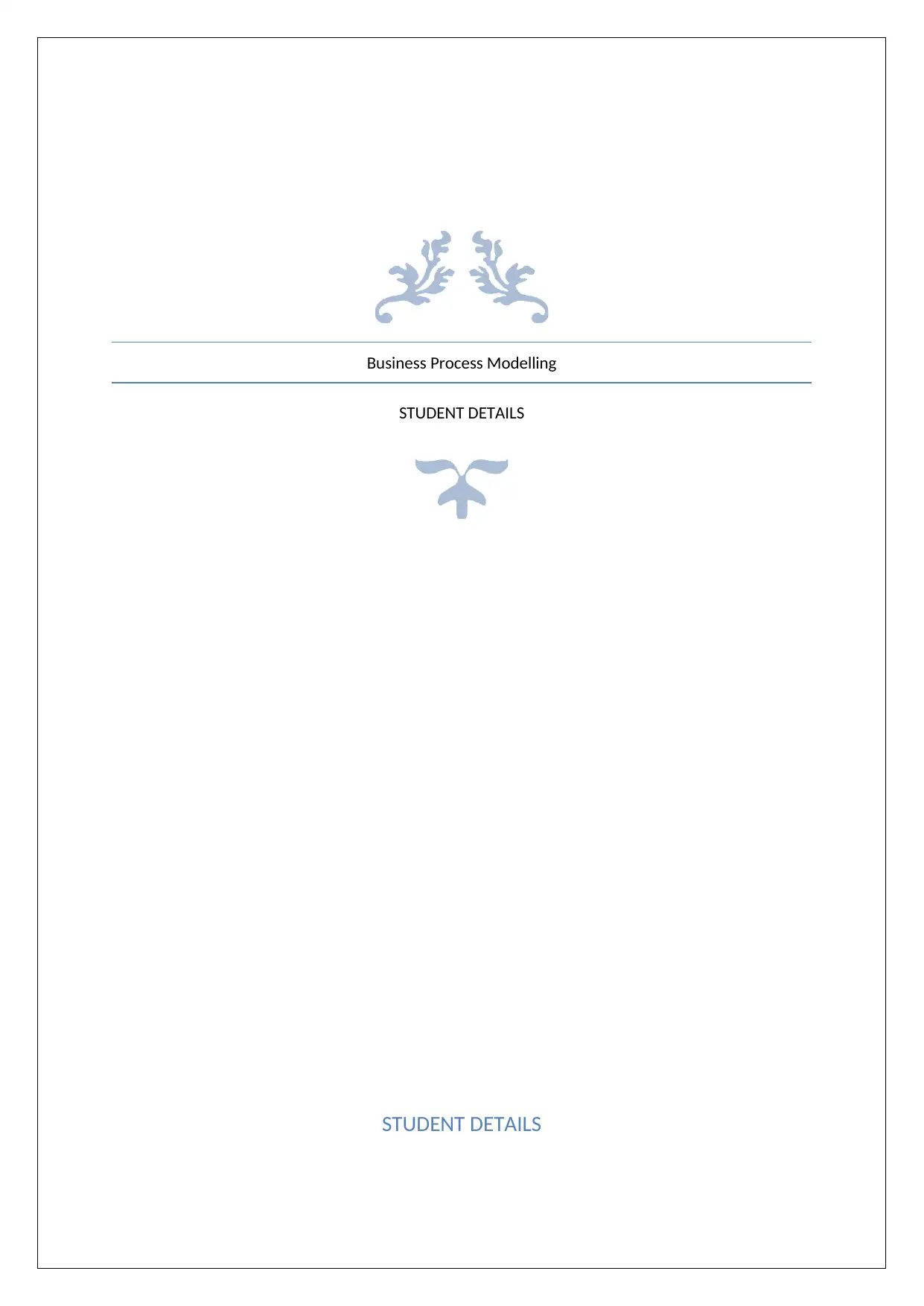
Business Process Modelling
STUDENT DETAILS
STUDENT DETAILS
STUDENT DETAILS
STUDENT DETAILS
Paraphrase This Document
Need a fresh take? Get an instant paraphrase of this document with our AI Paraphraser
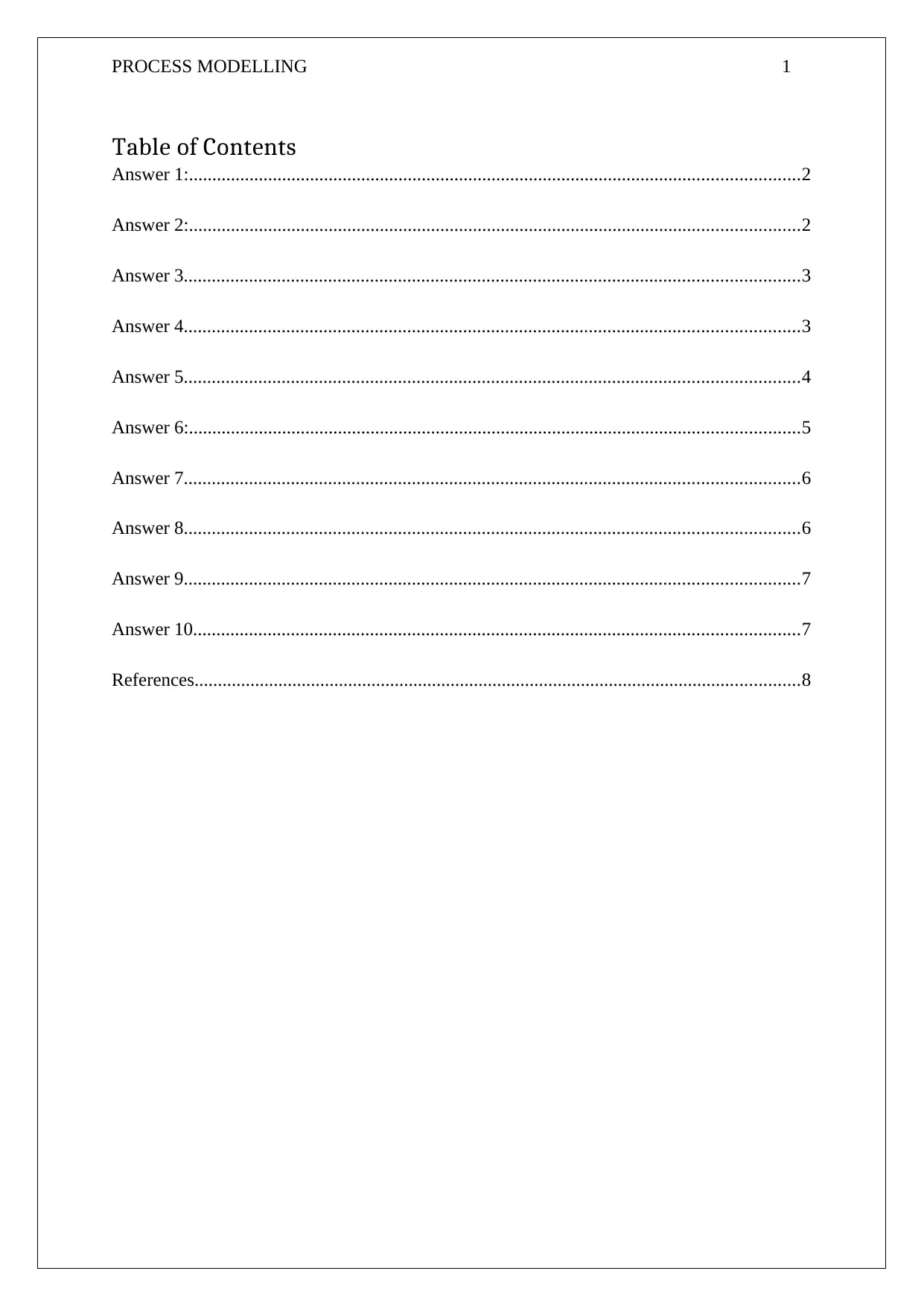
PROCESS MODELLING 1
Table of Contents
Answer 1:...................................................................................................................................2
Answer 2:...................................................................................................................................2
Answer 3....................................................................................................................................3
Answer 4....................................................................................................................................3
Answer 5....................................................................................................................................4
Answer 6:...................................................................................................................................5
Answer 7....................................................................................................................................6
Answer 8....................................................................................................................................6
Answer 9....................................................................................................................................7
Answer 10..................................................................................................................................7
References..................................................................................................................................8
Table of Contents
Answer 1:...................................................................................................................................2
Answer 2:...................................................................................................................................2
Answer 3....................................................................................................................................3
Answer 4....................................................................................................................................3
Answer 5....................................................................................................................................4
Answer 6:...................................................................................................................................5
Answer 7....................................................................................................................................6
Answer 8....................................................................................................................................6
Answer 9....................................................................................................................................7
Answer 10..................................................................................................................................7
References..................................................................................................................................8
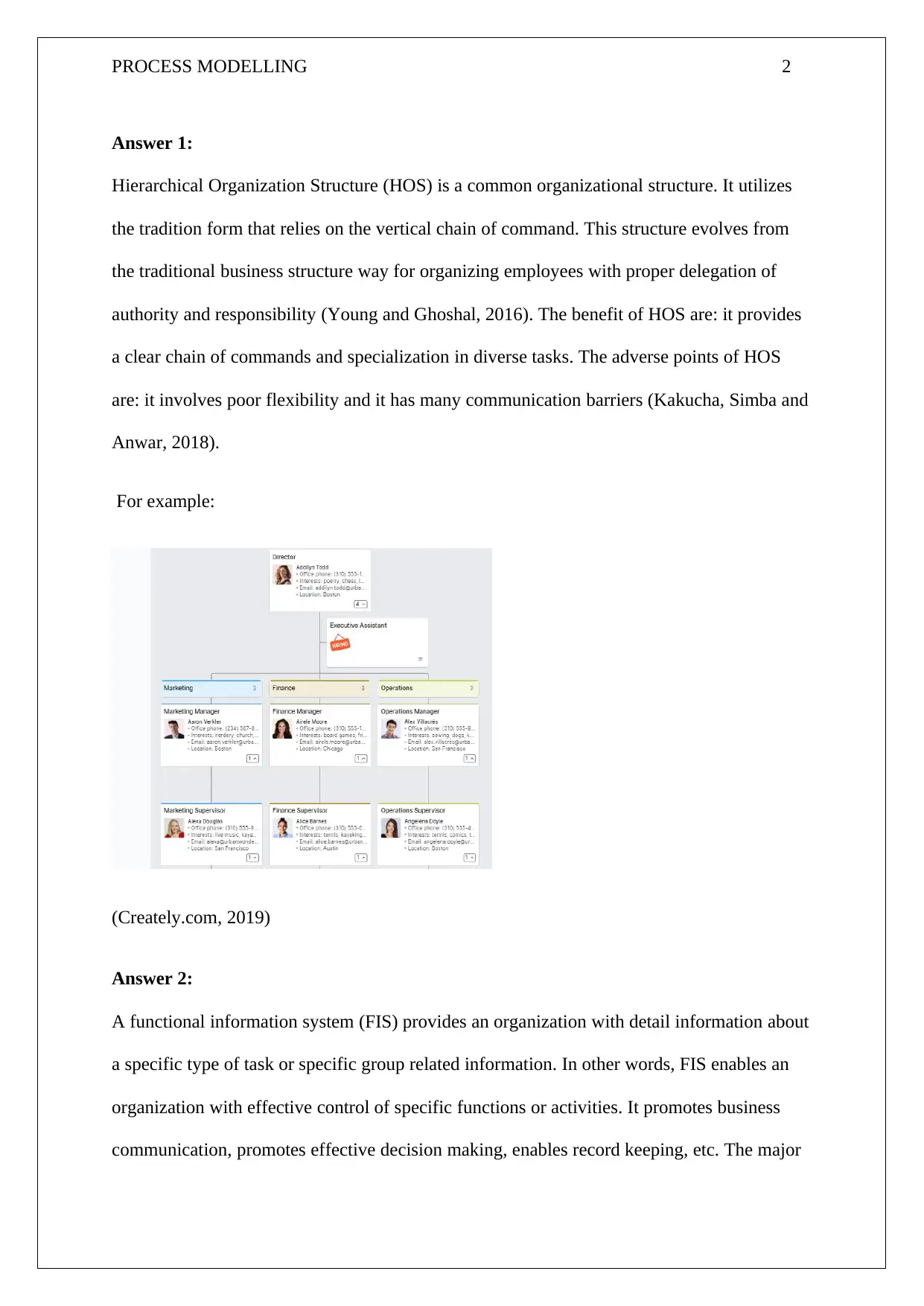
PROCESS MODELLING 2
Answer 1:
Hierarchical Organization Structure (HOS) is a common organizational structure. It utilizes
the tradition form that relies on the vertical chain of command. This structure evolves from
the traditional business structure way for organizing employees with proper delegation of
authority and responsibility (Young and Ghoshal, 2016). The benefit of HOS are: it provides
a clear chain of commands and specialization in diverse tasks. The adverse points of HOS
are: it involves poor flexibility and it has many communication barriers (Kakucha, Simba and
Anwar, 2018).
For example:
(Creately.com, 2019)
Answer 2:
A functional information system (FIS) provides an organization with detail information about
a specific type of task or specific group related information. In other words, FIS enables an
organization with effective control of specific functions or activities. It promotes business
communication, promotes effective decision making, enables record keeping, etc. The major
Answer 1:
Hierarchical Organization Structure (HOS) is a common organizational structure. It utilizes
the tradition form that relies on the vertical chain of command. This structure evolves from
the traditional business structure way for organizing employees with proper delegation of
authority and responsibility (Young and Ghoshal, 2016). The benefit of HOS are: it provides
a clear chain of commands and specialization in diverse tasks. The adverse points of HOS
are: it involves poor flexibility and it has many communication barriers (Kakucha, Simba and
Anwar, 2018).
For example:
(Creately.com, 2019)
Answer 2:
A functional information system (FIS) provides an organization with detail information about
a specific type of task or specific group related information. In other words, FIS enables an
organization with effective control of specific functions or activities. It promotes business
communication, promotes effective decision making, enables record keeping, etc. The major
⊘ This is a preview!⊘
Do you want full access?
Subscribe today to unlock all pages.

Trusted by 1+ million students worldwide
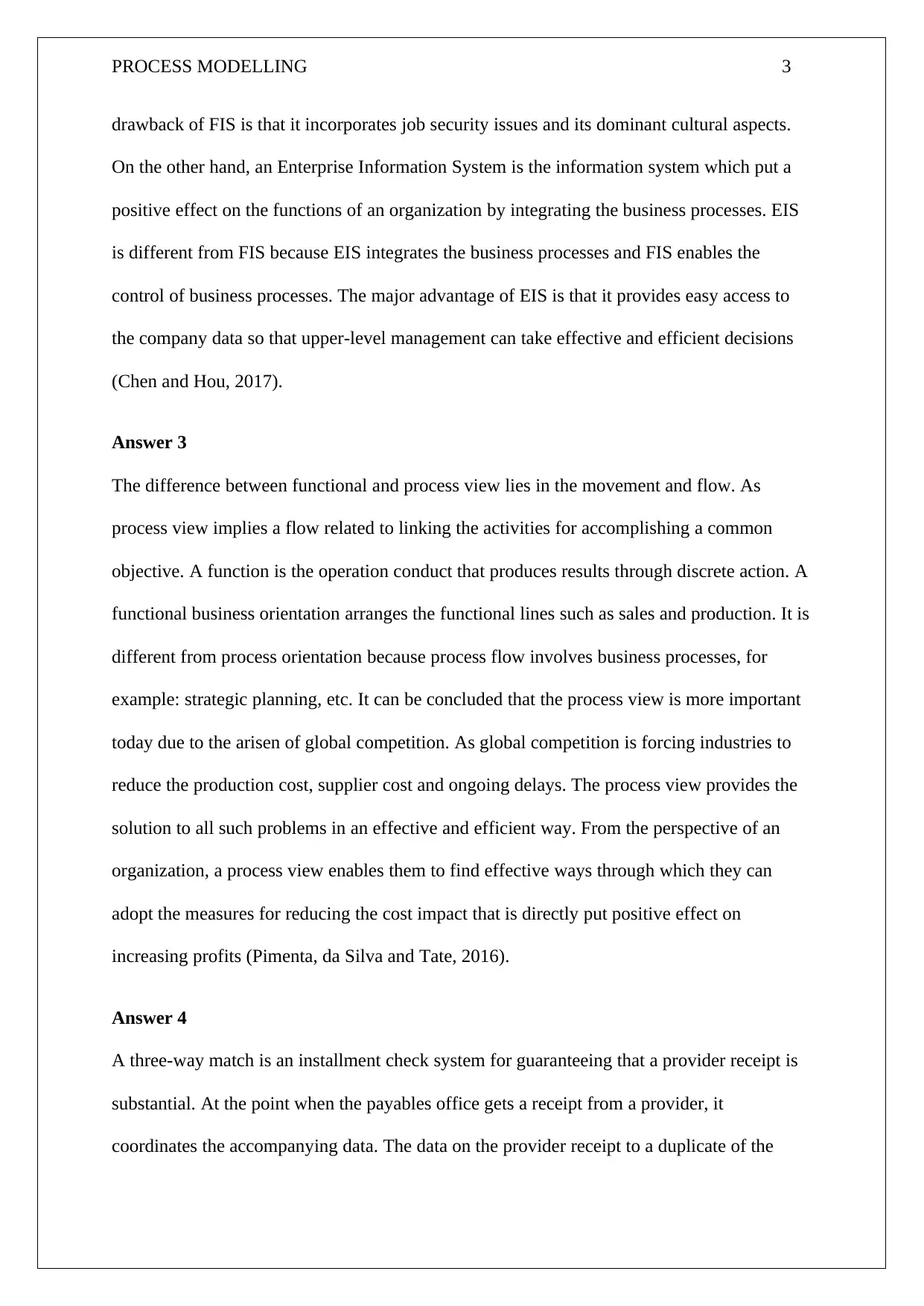
PROCESS MODELLING 3
drawback of FIS is that it incorporates job security issues and its dominant cultural aspects.
On the other hand, an Enterprise Information System is the information system which put a
positive effect on the functions of an organization by integrating the business processes. EIS
is different from FIS because EIS integrates the business processes and FIS enables the
control of business processes. The major advantage of EIS is that it provides easy access to
the company data so that upper-level management can take effective and efficient decisions
(Chen and Hou, 2017).
Answer 3
The difference between functional and process view lies in the movement and flow. As
process view implies a flow related to linking the activities for accomplishing a common
objective. A function is the operation conduct that produces results through discrete action. A
functional business orientation arranges the functional lines such as sales and production. It is
different from process orientation because process flow involves business processes, for
example: strategic planning, etc. It can be concluded that the process view is more important
today due to the arisen of global competition. As global competition is forcing industries to
reduce the production cost, supplier cost and ongoing delays. The process view provides the
solution to all such problems in an effective and efficient way. From the perspective of an
organization, a process view enables them to find effective ways through which they can
adopt the measures for reducing the cost impact that is directly put positive effect on
increasing profits (Pimenta, da Silva and Tate, 2016).
Answer 4
A three-way match is an installment check system for guaranteeing that a provider receipt is
substantial. At the point when the payables office gets a receipt from a provider, it
coordinates the accompanying data. The data on the provider receipt to a duplicate of the
drawback of FIS is that it incorporates job security issues and its dominant cultural aspects.
On the other hand, an Enterprise Information System is the information system which put a
positive effect on the functions of an organization by integrating the business processes. EIS
is different from FIS because EIS integrates the business processes and FIS enables the
control of business processes. The major advantage of EIS is that it provides easy access to
the company data so that upper-level management can take effective and efficient decisions
(Chen and Hou, 2017).
Answer 3
The difference between functional and process view lies in the movement and flow. As
process view implies a flow related to linking the activities for accomplishing a common
objective. A function is the operation conduct that produces results through discrete action. A
functional business orientation arranges the functional lines such as sales and production. It is
different from process orientation because process flow involves business processes, for
example: strategic planning, etc. It can be concluded that the process view is more important
today due to the arisen of global competition. As global competition is forcing industries to
reduce the production cost, supplier cost and ongoing delays. The process view provides the
solution to all such problems in an effective and efficient way. From the perspective of an
organization, a process view enables them to find effective ways through which they can
adopt the measures for reducing the cost impact that is directly put positive effect on
increasing profits (Pimenta, da Silva and Tate, 2016).
Answer 4
A three-way match is an installment check system for guaranteeing that a provider receipt is
substantial. At the point when the payables office gets a receipt from a provider, it
coordinates the accompanying data. The data on the provider receipt to a duplicate of the
Paraphrase This Document
Need a fresh take? Get an instant paraphrase of this document with our AI Paraphraser
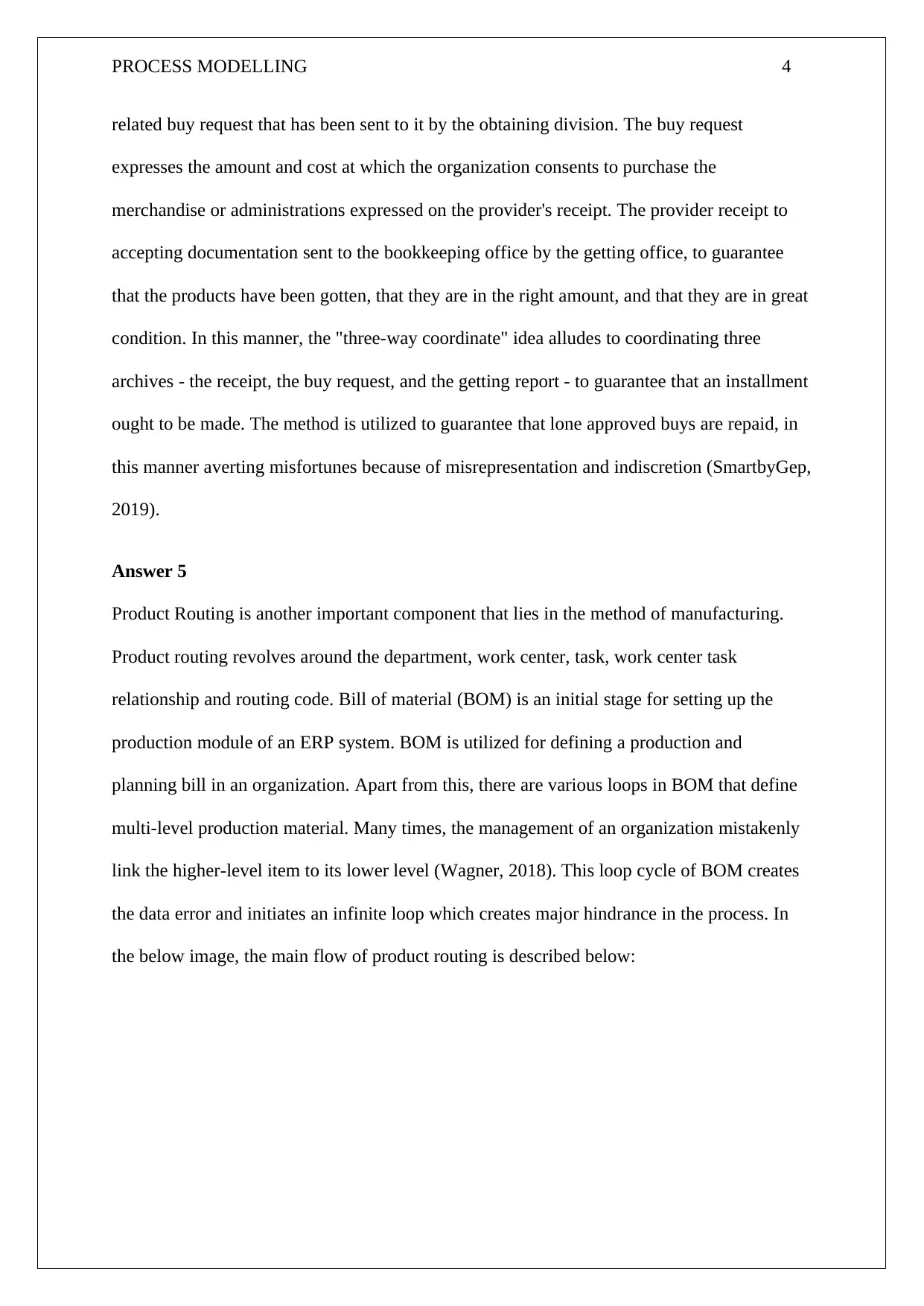
PROCESS MODELLING 4
related buy request that has been sent to it by the obtaining division. The buy request
expresses the amount and cost at which the organization consents to purchase the
merchandise or administrations expressed on the provider's receipt. The provider receipt to
accepting documentation sent to the bookkeeping office by the getting office, to guarantee
that the products have been gotten, that they are in the right amount, and that they are in great
condition. In this manner, the "three-way coordinate" idea alludes to coordinating three
archives - the receipt, the buy request, and the getting report - to guarantee that an installment
ought to be made. The method is utilized to guarantee that lone approved buys are repaid, in
this manner averting misfortunes because of misrepresentation and indiscretion (SmartbyGep,
2019).
Answer 5
Product Routing is another important component that lies in the method of manufacturing.
Product routing revolves around the department, work center, task, work center task
relationship and routing code. Bill of material (BOM) is an initial stage for setting up the
production module of an ERP system. BOM is utilized for defining a production and
planning bill in an organization. Apart from this, there are various loops in BOM that define
multi-level production material. Many times, the management of an organization mistakenly
link the higher-level item to its lower level (Wagner, 2018). This loop cycle of BOM creates
the data error and initiates an infinite loop which creates major hindrance in the process. In
the below image, the main flow of product routing is described below:
related buy request that has been sent to it by the obtaining division. The buy request
expresses the amount and cost at which the organization consents to purchase the
merchandise or administrations expressed on the provider's receipt. The provider receipt to
accepting documentation sent to the bookkeeping office by the getting office, to guarantee
that the products have been gotten, that they are in the right amount, and that they are in great
condition. In this manner, the "three-way coordinate" idea alludes to coordinating three
archives - the receipt, the buy request, and the getting report - to guarantee that an installment
ought to be made. The method is utilized to guarantee that lone approved buys are repaid, in
this manner averting misfortunes because of misrepresentation and indiscretion (SmartbyGep,
2019).
Answer 5
Product Routing is another important component that lies in the method of manufacturing.
Product routing revolves around the department, work center, task, work center task
relationship and routing code. Bill of material (BOM) is an initial stage for setting up the
production module of an ERP system. BOM is utilized for defining a production and
planning bill in an organization. Apart from this, there are various loops in BOM that define
multi-level production material. Many times, the management of an organization mistakenly
link the higher-level item to its lower level (Wagner, 2018). This loop cycle of BOM creates
the data error and initiates an infinite loop which creates major hindrance in the process. In
the below image, the main flow of product routing is described below:
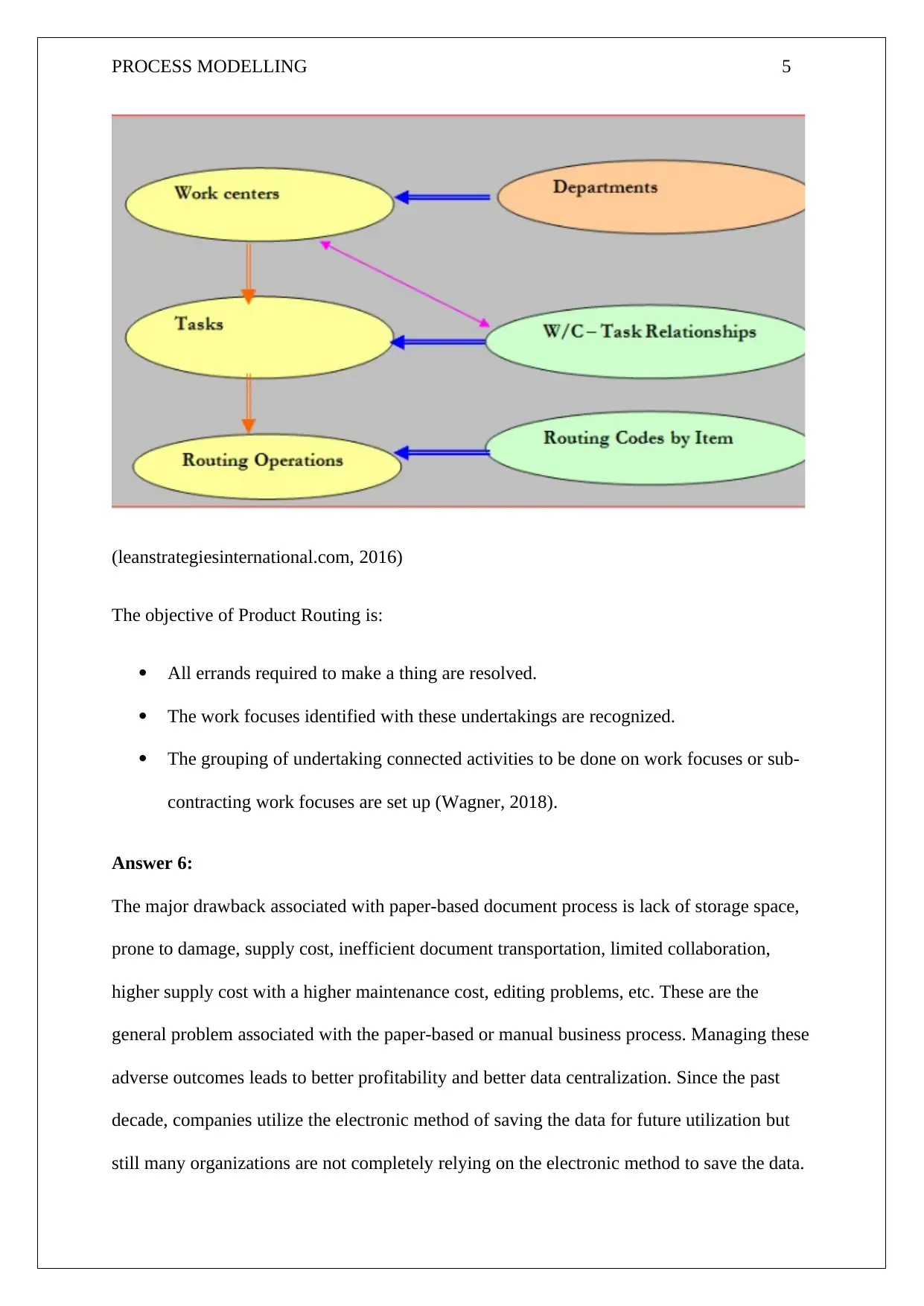
PROCESS MODELLING 5
(leanstrategiesinternational.com, 2016)
The objective of Product Routing is:
All errands required to make a thing are resolved.
The work focuses identified with these undertakings are recognized.
The grouping of undertaking connected activities to be done on work focuses or sub-
contracting work focuses are set up (Wagner, 2018).
Answer 6:
The major drawback associated with paper-based document process is lack of storage space,
prone to damage, supply cost, inefficient document transportation, limited collaboration,
higher supply cost with a higher maintenance cost, editing problems, etc. These are the
general problem associated with the paper-based or manual business process. Managing these
adverse outcomes leads to better profitability and better data centralization. Since the past
decade, companies utilize the electronic method of saving the data for future utilization but
still many organizations are not completely relying on the electronic method to save the data.
(leanstrategiesinternational.com, 2016)
The objective of Product Routing is:
All errands required to make a thing are resolved.
The work focuses identified with these undertakings are recognized.
The grouping of undertaking connected activities to be done on work focuses or sub-
contracting work focuses are set up (Wagner, 2018).
Answer 6:
The major drawback associated with paper-based document process is lack of storage space,
prone to damage, supply cost, inefficient document transportation, limited collaboration,
higher supply cost with a higher maintenance cost, editing problems, etc. These are the
general problem associated with the paper-based or manual business process. Managing these
adverse outcomes leads to better profitability and better data centralization. Since the past
decade, companies utilize the electronic method of saving the data for future utilization but
still many organizations are not completely relying on the electronic method to save the data.
⊘ This is a preview!⊘
Do you want full access?
Subscribe today to unlock all pages.

Trusted by 1+ million students worldwide
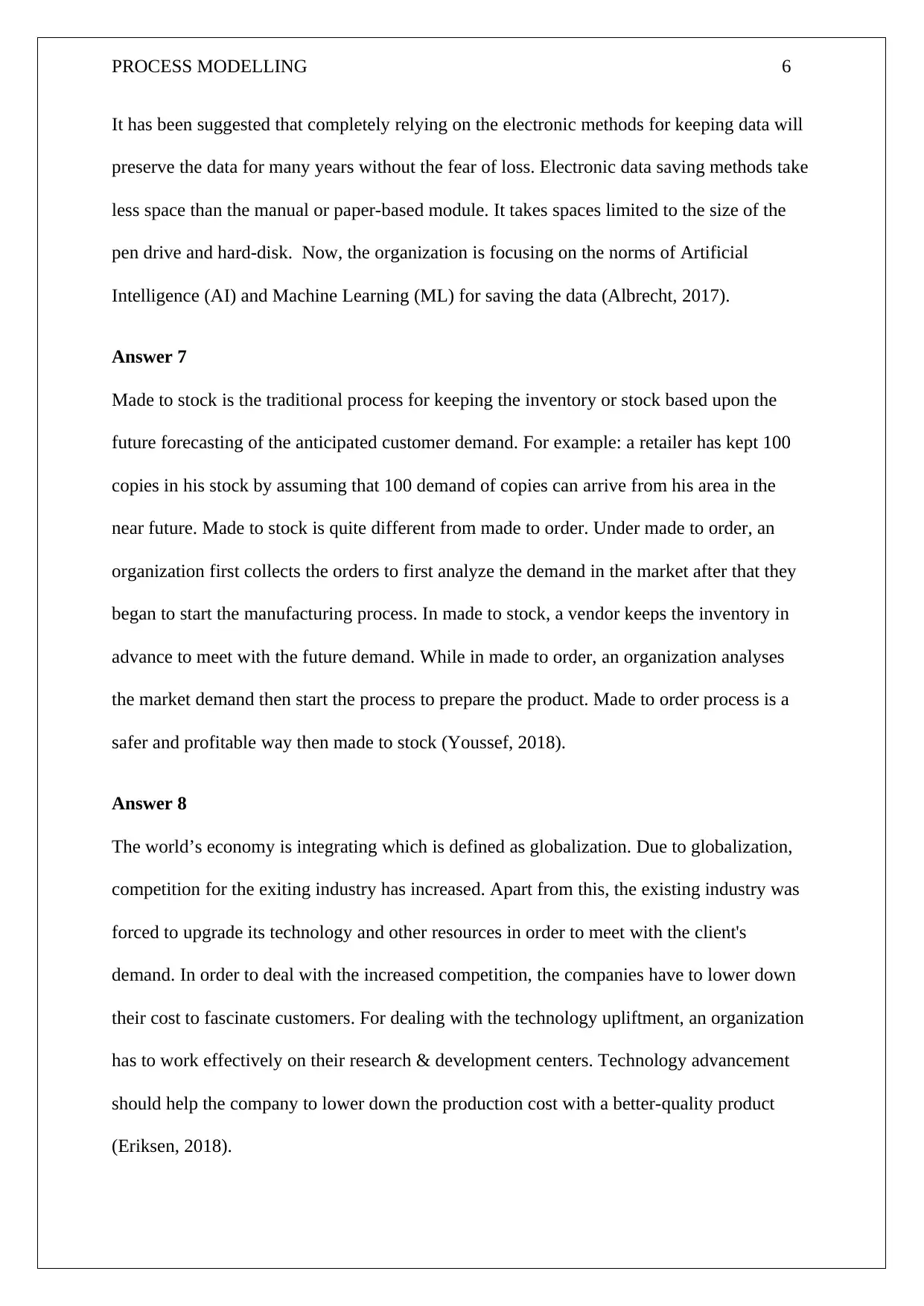
PROCESS MODELLING 6
It has been suggested that completely relying on the electronic methods for keeping data will
preserve the data for many years without the fear of loss. Electronic data saving methods take
less space than the manual or paper-based module. It takes spaces limited to the size of the
pen drive and hard-disk. Now, the organization is focusing on the norms of Artificial
Intelligence (AI) and Machine Learning (ML) for saving the data (Albrecht, 2017).
Answer 7
Made to stock is the traditional process for keeping the inventory or stock based upon the
future forecasting of the anticipated customer demand. For example: a retailer has kept 100
copies in his stock by assuming that 100 demand of copies can arrive from his area in the
near future. Made to stock is quite different from made to order. Under made to order, an
organization first collects the orders to first analyze the demand in the market after that they
began to start the manufacturing process. In made to stock, a vendor keeps the inventory in
advance to meet with the future demand. While in made to order, an organization analyses
the market demand then start the process to prepare the product. Made to order process is a
safer and profitable way then made to stock (Youssef, 2018).
Answer 8
The world’s economy is integrating which is defined as globalization. Due to globalization,
competition for the exiting industry has increased. Apart from this, the existing industry was
forced to upgrade its technology and other resources in order to meet with the client's
demand. In order to deal with the increased competition, the companies have to lower down
their cost to fascinate customers. For dealing with the technology upliftment, an organization
has to work effectively on their research & development centers. Technology advancement
should help the company to lower down the production cost with a better-quality product
(Eriksen, 2018).
It has been suggested that completely relying on the electronic methods for keeping data will
preserve the data for many years without the fear of loss. Electronic data saving methods take
less space than the manual or paper-based module. It takes spaces limited to the size of the
pen drive and hard-disk. Now, the organization is focusing on the norms of Artificial
Intelligence (AI) and Machine Learning (ML) for saving the data (Albrecht, 2017).
Answer 7
Made to stock is the traditional process for keeping the inventory or stock based upon the
future forecasting of the anticipated customer demand. For example: a retailer has kept 100
copies in his stock by assuming that 100 demand of copies can arrive from his area in the
near future. Made to stock is quite different from made to order. Under made to order, an
organization first collects the orders to first analyze the demand in the market after that they
began to start the manufacturing process. In made to stock, a vendor keeps the inventory in
advance to meet with the future demand. While in made to order, an organization analyses
the market demand then start the process to prepare the product. Made to order process is a
safer and profitable way then made to stock (Youssef, 2018).
Answer 8
The world’s economy is integrating which is defined as globalization. Due to globalization,
competition for the exiting industry has increased. Apart from this, the existing industry was
forced to upgrade its technology and other resources in order to meet with the client's
demand. In order to deal with the increased competition, the companies have to lower down
their cost to fascinate customers. For dealing with the technology upliftment, an organization
has to work effectively on their research & development centers. Technology advancement
should help the company to lower down the production cost with a better-quality product
(Eriksen, 2018).
Paraphrase This Document
Need a fresh take? Get an instant paraphrase of this document with our AI Paraphraser
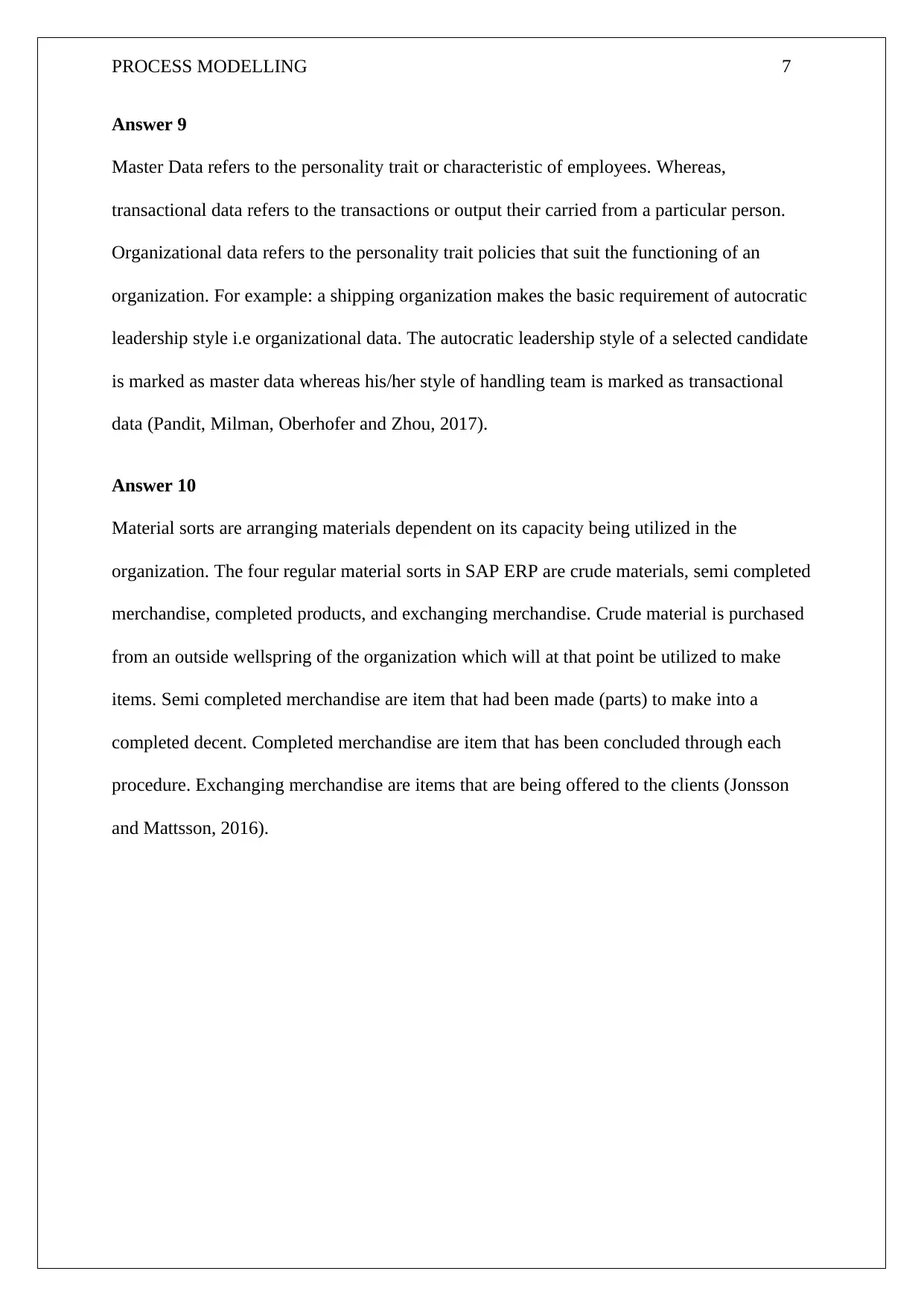
PROCESS MODELLING 7
Answer 9
Master Data refers to the personality trait or characteristic of employees. Whereas,
transactional data refers to the transactions or output their carried from a particular person.
Organizational data refers to the personality trait policies that suit the functioning of an
organization. For example: a shipping organization makes the basic requirement of autocratic
leadership style i.e organizational data. The autocratic leadership style of a selected candidate
is marked as master data whereas his/her style of handling team is marked as transactional
data (Pandit, Milman, Oberhofer and Zhou, 2017).
Answer 10
Material sorts are arranging materials dependent on its capacity being utilized in the
organization. The four regular material sorts in SAP ERP are crude materials, semi completed
merchandise, completed products, and exchanging merchandise. Crude material is purchased
from an outside wellspring of the organization which will at that point be utilized to make
items. Semi completed merchandise are item that had been made (parts) to make into a
completed decent. Completed merchandise are item that has been concluded through each
procedure. Exchanging merchandise are items that are being offered to the clients (Jonsson
and Mattsson, 2016).
Answer 9
Master Data refers to the personality trait or characteristic of employees. Whereas,
transactional data refers to the transactions or output their carried from a particular person.
Organizational data refers to the personality trait policies that suit the functioning of an
organization. For example: a shipping organization makes the basic requirement of autocratic
leadership style i.e organizational data. The autocratic leadership style of a selected candidate
is marked as master data whereas his/her style of handling team is marked as transactional
data (Pandit, Milman, Oberhofer and Zhou, 2017).
Answer 10
Material sorts are arranging materials dependent on its capacity being utilized in the
organization. The four regular material sorts in SAP ERP are crude materials, semi completed
merchandise, completed products, and exchanging merchandise. Crude material is purchased
from an outside wellspring of the organization which will at that point be utilized to make
items. Semi completed merchandise are item that had been made (parts) to make into a
completed decent. Completed merchandise are item that has been concluded through each
procedure. Exchanging merchandise are items that are being offered to the clients (Jonsson
and Mattsson, 2016).
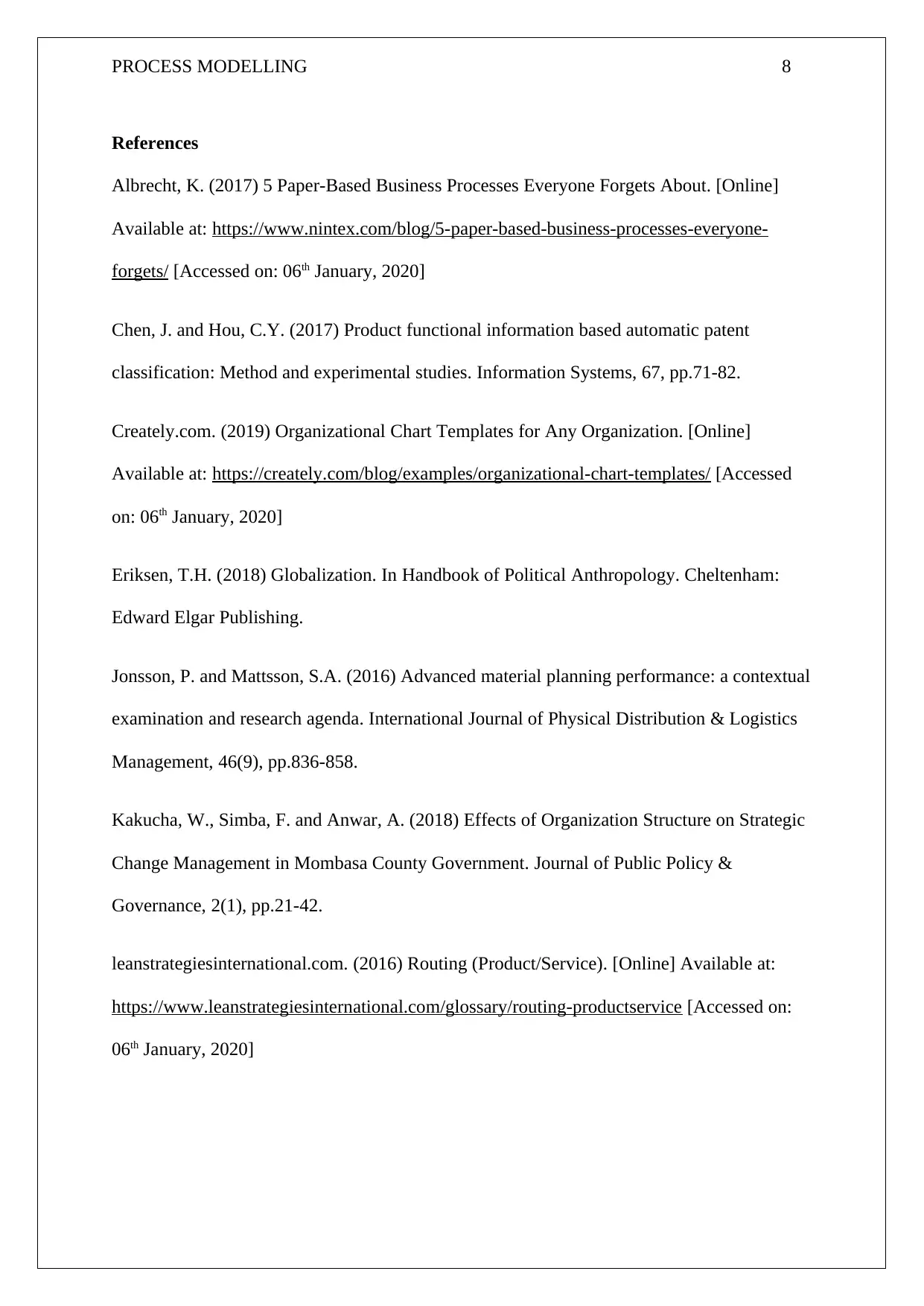
PROCESS MODELLING 8
References
Albrecht, K. (2017) 5 Paper-Based Business Processes Everyone Forgets About. [Online]
Available at: https://www.nintex.com/blog/5-paper-based-business-processes-everyone-
forgets/ [Accessed on: 06th January, 2020]
Chen, J. and Hou, C.Y. (2017) Product functional information based automatic patent
classification: Method and experimental studies. Information Systems, 67, pp.71-82.
Creately.com. (2019) Organizational Chart Templates for Any Organization. [Online]
Available at: https://creately.com/blog/examples/organizational-chart-templates/ [Accessed
on: 06th January, 2020]
Eriksen, T.H. (2018) Globalization. In Handbook of Political Anthropology. Cheltenham:
Edward Elgar Publishing.
Jonsson, P. and Mattsson, S.A. (2016) Advanced material planning performance: a contextual
examination and research agenda. International Journal of Physical Distribution & Logistics
Management, 46(9), pp.836-858.
Kakucha, W., Simba, F. and Anwar, A. (2018) Effects of Organization Structure on Strategic
Change Management in Mombasa County Government. Journal of Public Policy &
Governance, 2(1), pp.21-42.
leanstrategiesinternational.com. (2016) Routing (Product/Service). [Online] Available at:
https://www.leanstrategiesinternational.com/glossary/routing-productservice [Accessed on:
06th January, 2020]
References
Albrecht, K. (2017) 5 Paper-Based Business Processes Everyone Forgets About. [Online]
Available at: https://www.nintex.com/blog/5-paper-based-business-processes-everyone-
forgets/ [Accessed on: 06th January, 2020]
Chen, J. and Hou, C.Y. (2017) Product functional information based automatic patent
classification: Method and experimental studies. Information Systems, 67, pp.71-82.
Creately.com. (2019) Organizational Chart Templates for Any Organization. [Online]
Available at: https://creately.com/blog/examples/organizational-chart-templates/ [Accessed
on: 06th January, 2020]
Eriksen, T.H. (2018) Globalization. In Handbook of Political Anthropology. Cheltenham:
Edward Elgar Publishing.
Jonsson, P. and Mattsson, S.A. (2016) Advanced material planning performance: a contextual
examination and research agenda. International Journal of Physical Distribution & Logistics
Management, 46(9), pp.836-858.
Kakucha, W., Simba, F. and Anwar, A. (2018) Effects of Organization Structure on Strategic
Change Management in Mombasa County Government. Journal of Public Policy &
Governance, 2(1), pp.21-42.
leanstrategiesinternational.com. (2016) Routing (Product/Service). [Online] Available at:
https://www.leanstrategiesinternational.com/glossary/routing-productservice [Accessed on:
06th January, 2020]
⊘ This is a preview!⊘
Do you want full access?
Subscribe today to unlock all pages.

Trusted by 1+ million students worldwide
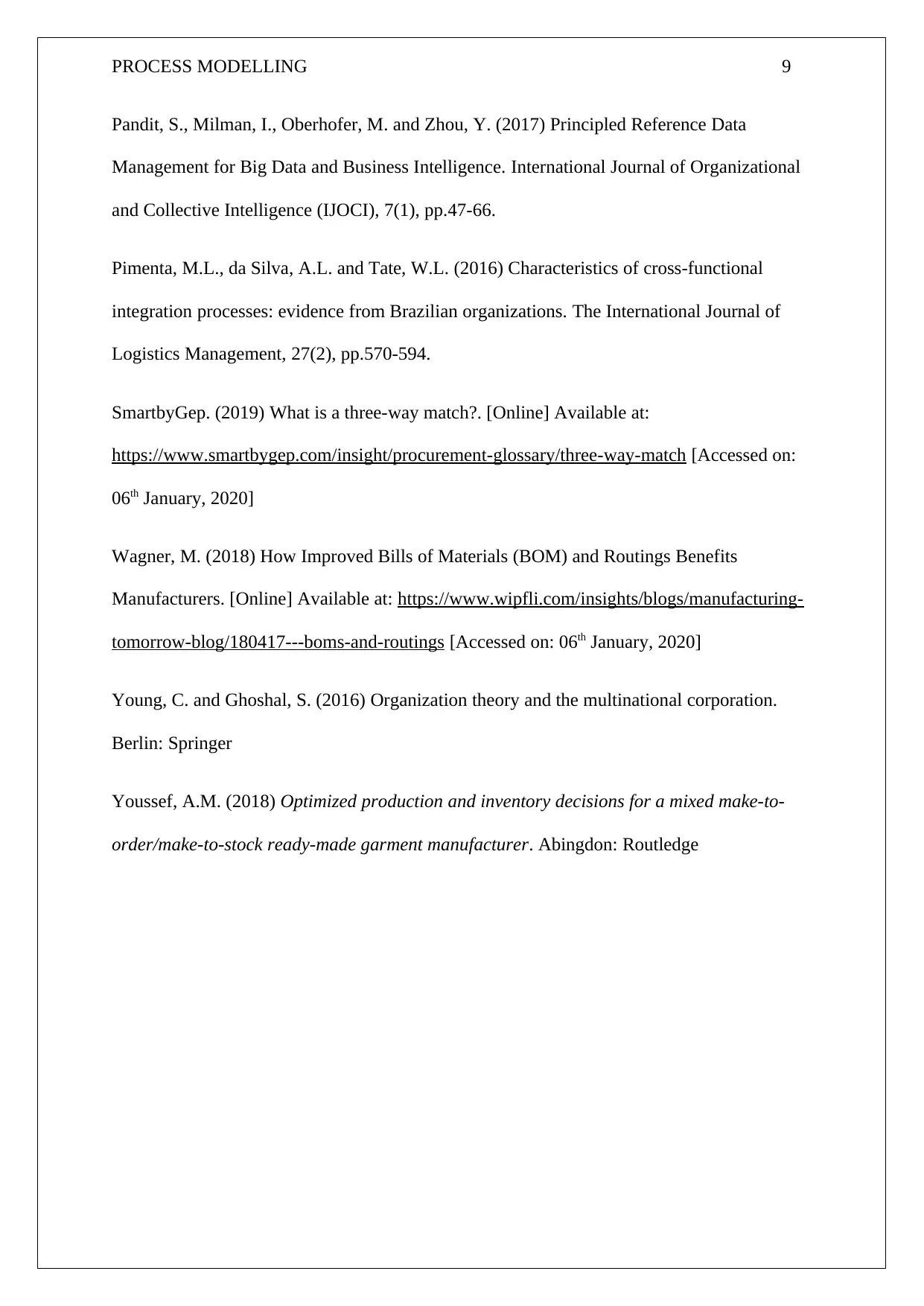
PROCESS MODELLING 9
Pandit, S., Milman, I., Oberhofer, M. and Zhou, Y. (2017) Principled Reference Data
Management for Big Data and Business Intelligence. International Journal of Organizational
and Collective Intelligence (IJOCI), 7(1), pp.47-66.
Pimenta, M.L., da Silva, A.L. and Tate, W.L. (2016) Characteristics of cross-functional
integration processes: evidence from Brazilian organizations. The International Journal of
Logistics Management, 27(2), pp.570-594.
SmartbyGep. (2019) What is a three-way match?. [Online] Available at:
https://www.smartbygep.com/insight/procurement-glossary/three-way-match [Accessed on:
06th January, 2020]
Wagner, M. (2018) How Improved Bills of Materials (BOM) and Routings Benefits
Manufacturers. [Online] Available at: https://www.wipfli.com/insights/blogs/manufacturing-
tomorrow-blog/180417---boms-and-routings [Accessed on: 06th January, 2020]
Young, C. and Ghoshal, S. (2016) Organization theory and the multinational corporation.
Berlin: Springer
Youssef, A.M. (2018) Optimized production and inventory decisions for a mixed make-to-
order/make-to-stock ready-made garment manufacturer. Abingdon: Routledge
Pandit, S., Milman, I., Oberhofer, M. and Zhou, Y. (2017) Principled Reference Data
Management for Big Data and Business Intelligence. International Journal of Organizational
and Collective Intelligence (IJOCI), 7(1), pp.47-66.
Pimenta, M.L., da Silva, A.L. and Tate, W.L. (2016) Characteristics of cross-functional
integration processes: evidence from Brazilian organizations. The International Journal of
Logistics Management, 27(2), pp.570-594.
SmartbyGep. (2019) What is a three-way match?. [Online] Available at:
https://www.smartbygep.com/insight/procurement-glossary/three-way-match [Accessed on:
06th January, 2020]
Wagner, M. (2018) How Improved Bills of Materials (BOM) and Routings Benefits
Manufacturers. [Online] Available at: https://www.wipfli.com/insights/blogs/manufacturing-
tomorrow-blog/180417---boms-and-routings [Accessed on: 06th January, 2020]
Young, C. and Ghoshal, S. (2016) Organization theory and the multinational corporation.
Berlin: Springer
Youssef, A.M. (2018) Optimized production and inventory decisions for a mixed make-to-
order/make-to-stock ready-made garment manufacturer. Abingdon: Routledge
Paraphrase This Document
Need a fresh take? Get an instant paraphrase of this document with our AI Paraphraser
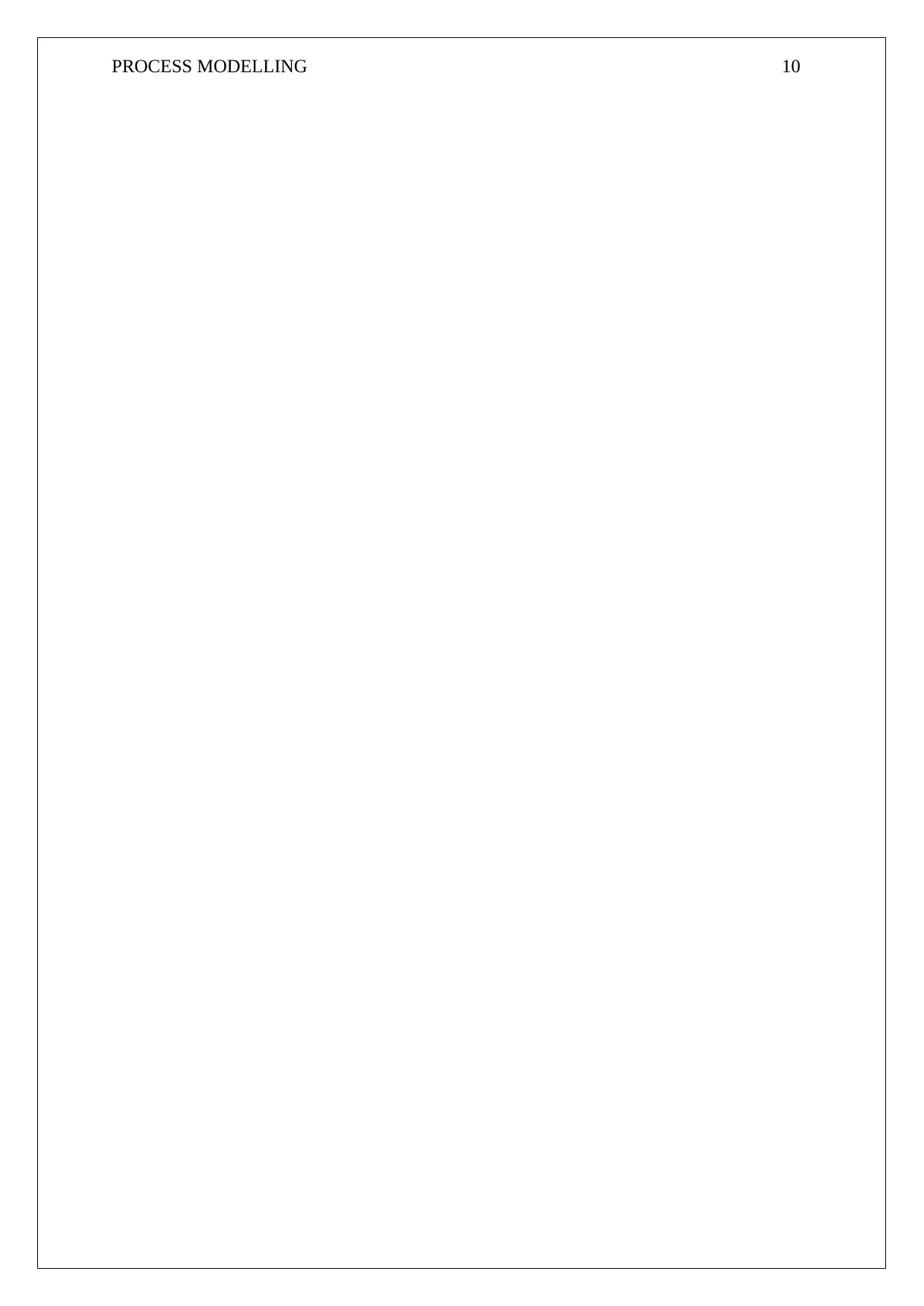
PROCESS MODELLING 10
1 out of 11
Related Documents
Your All-in-One AI-Powered Toolkit for Academic Success.
+13062052269
info@desklib.com
Available 24*7 on WhatsApp / Email
![[object Object]](/_next/static/media/star-bottom.7253800d.svg)
Unlock your academic potential
Copyright © 2020–2025 A2Z Services. All Rights Reserved. Developed and managed by ZUCOL.





